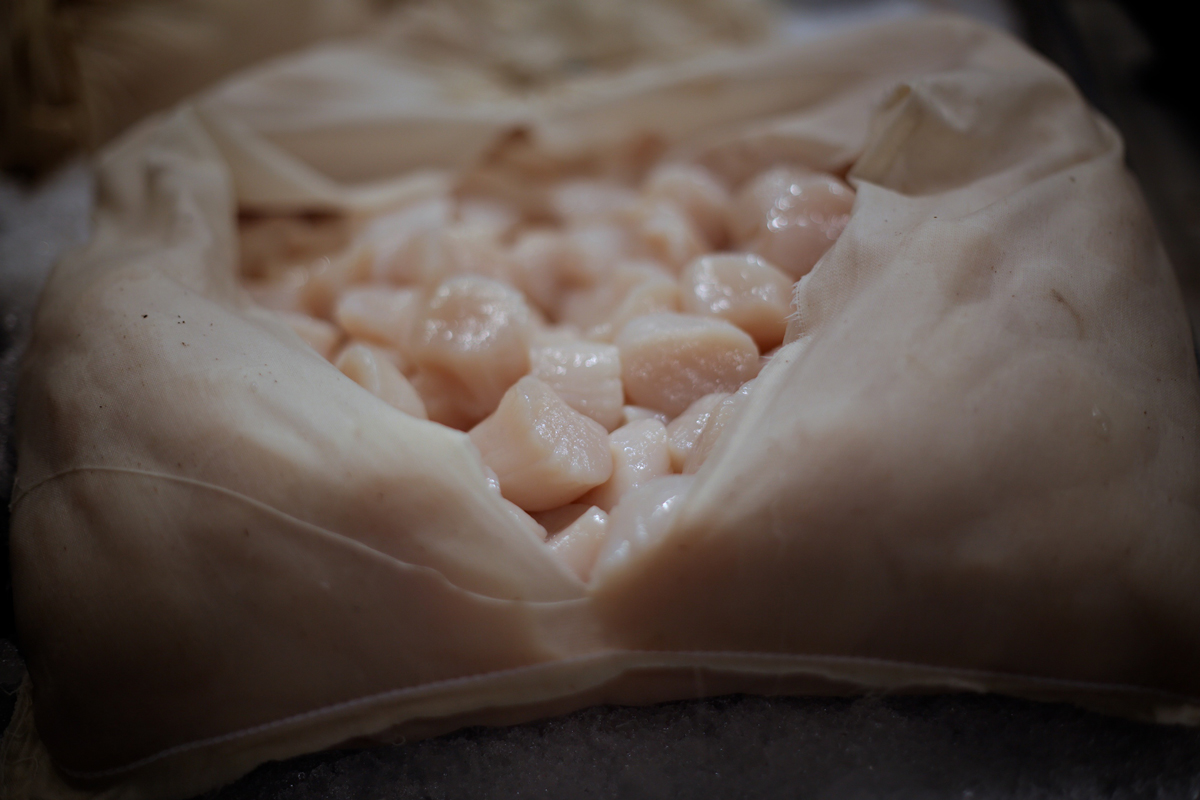The neighborhood of Hunts Point, in the South Bronx, is forbidding in the early morning hours. Lodged beneath a knot of expressways, river on all sides, its dark industrial streets are lined with low barbed wire-edged buildings. A non-stop stream of long-haul trucks rumbles in from all over, with fresh edible cargo, billions of pounds each year—vegetables, meat, fish. That’s why we’re here. Where the Bronx and East Rivers meet sits the New Fulton Fish Market, the oldest in the U.S., and the second largest on the planet after Tokyo.
The action starts early at the New Fulton Fish Market: Monday through Friday at one a.m. Outside, in a fog lit by the sprawling warehouse, trucks park higgledy-piggledy. They make a maze that hi-lo forklifts whiz around, beeping. Men in hoodies huddle over wet cardboard boxes. They argue. They smoke. One guy starts jumping rope. And here comes a young dude waving a heavy steel hook, as big as his face, asking for our parking ticket.
That’s the first thing you notice at the market, all the guys have hooks. As in Captain Hook: big and sharp, with wooden butts. They use them like extensions of their arms, like second nature. “I’ve never once used it as a weapon,” says Ed Cruci, one of the first fish sellers we stop to talk with. “I couldn’t work without it. I wouldn’t even come onto the floor without it. The only thing we don’t do with our hooks is masturbate. Just to show you how versatile this tool is.”
Inside, on the floor, the activity continues. The long space is generously partitioned into areas by wholesaler. Within each area, so many fish washed up and staring in the bright cold florescent light! All colors and kinds: snappers, swordfish, tuna, mullet, pompano, perch, sea bass, shark, skate. On ice, their silvery skin and eyes shine like jewels. A man runs his hand over the backs of crayfish packed tight and, briefly, the whole box comes alive.
“After forty-one years, I still like it. I still like what I’m doing,” Robert DiGregorio tells us. He’s the resident tuna expert, with a book on the topic to prove it.Tuna Grading and Evaluation: The Complete Tuna Buyer’s Handbook, available on Amazon. “I like to handle the fish. I feel like I’m fulfilling God’s plan for the tuna. Feeding the people. I’m just a link in the chain.”
In 1972 DiGregorio came home from the Marines with no clear next step. A friend brought him down to the market, and that was that. It’s a story many of the guys at the market share. Jerry Phillips, another fish seller, came into the business through his older brother thirty years back. At that time, the Fulton Fish Market was actually down on Fulton Street, in Manhattan, near Wall Street and the South Street Sea Port, close to where the market first opened in 1807. “In summer, you had the sun rising over the Brooklyn Bridge. It was great,” Phillips recalls. Another fish seller butts in. “It was a real shit hole,” he says. Cobblestone streets. No fork lifts. “When it snowed, we got snowed on. When it rained, we got rained on.” And yet the old market was exciting. On that, they can agree. “You had all these girls flashing their boobs. You didn’t know if someone was getting murdered or shot. In the old days, everything went. Barbara Streisand. Nick Nolte. Everyone made a movie down there. And we had to deal with the gangsters!”
In 2005 the market moved up to its current location in the South Bronx, a much improved, custom-built, four hundred thousand square foot facility, with ample refrigeration and mechanical movers. According to the New Fulton Fish Market Cooperative, the market is now home to thirty-seven wholesale operations that handle about one third of New York’s total seafood demand, and about five percent of U.S. seafood sales. That’s millions of pounds of seafood daily, up to three hundred varieties, with annual sales in the billions.
Tim Wilkisson’s family has been responsible for a lot of that business. They’ve been at it for four generations, over a hundred thirty years. “I was going to be the next Jacques Cousteau. Didn’t work out. No money in it,” says Wilkisson wryly. In fact, he dropped out of college in his third year to help his father and his mother, then in need of open heart surgery. His father begged him not to. “Thank God I did,” Wilkisson goes on. “I got to work side by side with my father for a year. Then one day he took a heart attack in my arms, and I drove him to the hospital.” It was then that his father, with a formal salute, handed over the heart of his business, a little black book with all his customers’ details. “So at age 22, I’m running the oldest fish company there is. It was a big reality check.”
Wilkisson’s stepson—a lanky teen with long hair in a black stocking cap—heaves a shovel to spread some fresh ice on the snapper. Wilkisson takes out an iPhone and starts flicking through photos. He wants to introduce us to the next generation in the business: a smiling baby boy holding both toes. “It’s in our blood,” he says. “Some people are in it. Some people aren’t.”
A whole day passes at the fish market before the rest of the city gets out of bed. “You can still make a living in the world being honest,” Wilkisson wants us to know. “You don’t need to be a scum bag.”
Photos by J.R. Sheetz.















